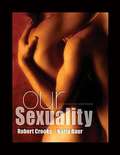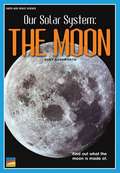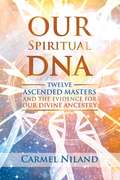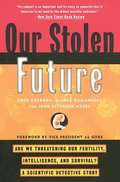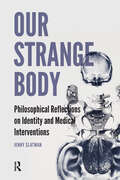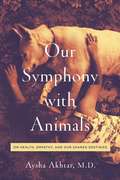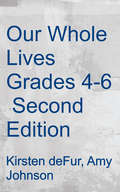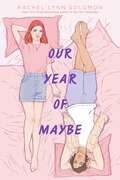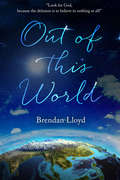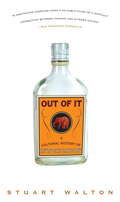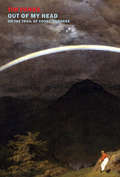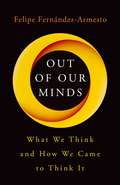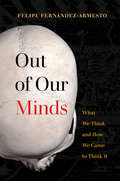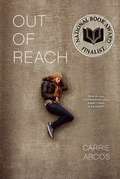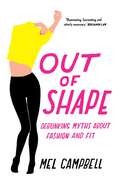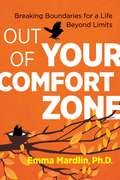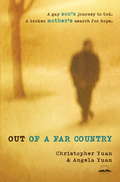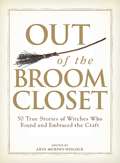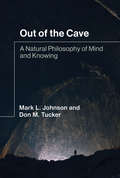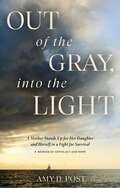- Table View
- List View
Our Sexuality (11th Edition)
by Karla Baur Robert CrooksThis is the most respected and authoritative college textbook available on human sexuality. Written in a direct, non-judgmental manner, this edition of OUR SEXUALITY has been thoroughly and carefully updated to reflect the most current research findings. It is the first college text to bring cutting-edge and in-depth emphasis on the impact of politics on sexuality. Crooks and Baur keep you interested with the most exciting, emerging research and coverage, and focus on strengthening healthy communication among partners. The authors also have revised their overall coverage on maintaining a responsible and healthy sexual relationship, with greater attention to diversity and inclusiveness.
Our Solar System: The Moon
by Pam Hirschfeld Garry RushworthFind out about where the moon came from and find out about its properties.
Our Spiritual DNA: Twelve Ascended Masters and the Evidence for Our Divine Ancestry
by Carmel Niland• Investigates the roles, energies, and essence of 12 Ascended Masters and how each of them holds a strand of our spiritual DNA • Traces the reincarnations of Ascended Masters Mother Mary and St. Germain through history, depicting the positive and shadow aspects of their archetypal energies • Offers charts that allow you to find out which Ascended Master you relate to and thus discover your own direct connection to the Divine DO YOU KNOW what Imhotep, Homer, and Nikola Tesla have in common? All three are said to be influential incarnations of Ascended Master St. Germain. How can we tell? Guided by renowned mystics, Carmel Niland suggests that, just as we carry physical DNA that shapes us across generations, we also carry an energetic code or spiritual DNA that links us back to the very source of our origins -- God -- a divine ancestry that throughout the centuries conveys itself in patterns of behavior, character traits, and life purpose, connecting each individual to a specific Ascended Master. The God essence expresses itself through archetypal energies in us, represented by 12 Ascended Masters who hold the 12 strands of our spiritual DNA. Thus, every person on this earth, no matter how ordinary or extraordinary, is an aspect of one of these Masters. Focusing on Mother Mary and St. Germain, Our Spiritual DNA explores the role, energies, and essence of these 12 Masters by examining some of history&’s most important figures who have been instrumental in shaping our world. Hitherto unknown details about the lives of personalities like Queen Nefertiti, Julius Caesar, Cleopatra, Merlin, Isabelle of Castile, and Dante emerge in channeled conversations with the author&’s spiritual guide, The Gatekeeper. Revolutionizing the Western view of reincarnation, this astounding book allows you to trace your own spiritual DNA through the reincarnations of the Ascended Masters, understand your spiritual and genetic connection to God, and realize that we are all divinely connected across gender, race, and time.
Our Stolen Future: Are We Threatening Our Fertility, Intelligence, and Survival? A Scientific Detective Story
by Theo Colborn Dianne Dumanoski John Peterson MyersOver thirty years ago, Rachel Carson's Silent Spring first warned that man-made chemicals were taking a deadly toll on birds and wildlife. Only now, however, are we recognizing the full consequences of this insidious threat, which is derailing sexual development and reproduction-not only in a host of animal populations but, it appears, in humans as well. Written by two leading environmental scientists and an award-winning environmental journalist, Our Stolen Future has already become one of the most controversial and talked-about books of the decade. Picking up where Silent Spring left off, this groundbreaking work gives an utterly gripping account that traces birth defects, sexual abnormalities, and reproductive failures in wildlife to their source-synthetic chemicals that mimic natural hormones, upsetting normal reproductive and developmental processes. And humans appear far from immune to the effects of these "hormone impostors." Male sperm counts have dropped as much as 50 percent in recent decades, while women have suffered a dramatic rise in hormone-related cancers, endometriosis, and other disorders. By threatening the ability to reproduce, these chemicals may be invisibly undermining the human future. Piecing together the clues, the authors detail how these industrial pollutants have spread with ease through the web of life from the equator to the poles, and explore what we can and must do to combat this invasion. Timely, urgent, and scrupulously reported, this riveting story of scientific detection will have a major impact on public debate for decades to come. It is indispensable for those concerned about the profound human impact on the environment, the well-being of our children, and the survival of our species.
Our Strange Body: Philosophical Reflections on Identity and Medical Interventions
by Jenny SlatmanThe ever increasing ability of medical technology to reshape the human body in fundamental ways - from organ and tissue transplants to reconstructive surgery and prosthetics - is something now largely taken for granted. But for a philosopher, such interventions raise fundamental and fascinating questions about our sense of individual identity and its relationship to the physical body. Drawing on and engaging with philosophers from across the centuries, Jenny Slatman here develops a novel argument: that our own body always entails a strange dimension, a strangeness that enables us to incorporate radical physical changes.
Our Symphony with Animals: On Health, Empathy, And Our Shared Destinies
by Aysha AkhtarA leader in the fields of animal ethics and neurology, Dr. Aysha Akhtar examines the rich human-animal connection and how interspecies empathy enriches our well-being. Deftly combining medicine, social history and personal experience, Our Symphony with Animals is the first book by a physician to show how deeply the well-being of humans and animals are entwined. Interwoven throughout is Dr. Akhtar’s own story of being a young girl who was bullied in school and sexually abused by her uncle. Feeling abandoned by humanity, it was only when she met Sylvester, a dog who had also been abused, that she found strength for both of them. Against the backdrop of her inspiring story, Dr. Akhtar asks, what do we gain when we recognize our kinship with animals? She travels around the country to tell the stories of a varied cast of characters—including a former mobster, an industrial chicken farmer, a Marine veteran—and comes face to face with a serial killer. Through storytelling that is entertaining, profound, and touching, Dr. Akhtar reveals what happens when we both break and forge bonds with animals. She demonstrates how humans are neurologically designed to empathize with animals, and how violence against them goes against our nature. In equal measure, the love and friendship we give to other species biologically reverberates back to us. Humanity’s compassion for animals is the next step in our species’ moral evolution and a vital component of our own health. Our Symphony with Animals is the definitive account for why our relationships with animals matter.
Our Whole Lives: Sexuality Education for Grades 4-6
by Amy Johnson Kirsten DeFurOur Whole Lives: Sexuality Education for Grades 4-6
Our Year of Maybe
by Rachel Lynn SolomonFrom the author of You’ll Miss Me When I’m Gone comes a stunning contemporary novel that examines the complicated aftermath of a kidney transplant between best friends. <P><P>Aspiring choreographer Sophie Orenstein would do anything for Peter Rosenthal-Porter, who’s been on the kidney transplant list as long as she’s known him. Peter, a gifted pianist, is everything to Sophie: best friend, musical collaborator, secret crush. <P><P>When she learns she’s a match, donating a kidney is an easy, obvious choice. She can’t help wondering if after the transplant, he’ll love her back the way she’s always wanted. But Peter’s life post-transplant isn’t what either of them expected. <P><P>Though he once had feelings for Sophie, too, he’s now drawn to Chase, the guitarist in a band that happens to be looking for a keyboardist. <P><P>And while neglected parts of Sophie’s world are calling to her—dance opportunities, new friends, a sister and niece she barely knows—she longs for a now-distant Peter more than ever, growing increasingly bitter he doesn’t seem to feel the same connection. <P><P>Peter fears he’ll forever be indebted to her. Sophie isn’t sure who she is without him. <P><P>Then one heartbreaking night twists their relationship into something neither of them recognizes, leading them to question their past, their future, and whether their friendship is even worth fighting for.
Out Of This World
by Brendan LloydHave you ever considered spirituality but decided you couldn't make sense of all the jargon? You're not alone. Why settle for 'New Age' when you don't understand the Age-Old?In this book, you'll discover real experiences and real insight - nothing fictional, or second-hand (except maybe this book one day). If you don't think (even slightly) differently after reading this book, either you're not thinking enough, or you didn't stop and think 'Why are we here?'To quote the original Matrix film, 'Free your mind'; discover possibilities you thought were impossible, when you already knew the Mission was Impossible. But this one doesn't come with popcorn!I'm not here to tell you to 'look within', or that 'the Kingdom of God is within', I'm here to tell you - look for God, because the delusion is to believe in nothing at all!
Out in the Open, Revised Edition
by R. Louis Schultz Marcelo CoutinhoOut in the Open, Revised Edition: The Complete Male Pelvis offers a frank exploration of the male pelvic region from a cultural and scientific perspective. Focusing on pelvic structure and development, the book explains how male sexuality develops throughout a man's life--from birth onwards. An experienced Rolfer with an academic background in physiology, the late author R. Louis Schultz, PhD, offers the fruits of his wisdom gleaned over the course of his twenty-five year bodywork career. A valuable guide for bodyworkers and laypeople alike, the book addresses such topics as: * Genital structure * Bodywork techniques to treat pelvic tightness * Erection, masturbation, and ejaculation * The link between emotion and male sexuality * Sexual stereotypes and mythsEnhanced with over 120 detailed photos and illustrations, the book offers valuable advice for bodyworkers working in the pelvic region, a possible area of tension and more serious pelvic conditions. Revised by Schultz's protégé, Advanced Rolfer Marcelo Coutinho, this edition includes a redesigned cover, a new foreword by Coutinho, and an added appendix of 20 exercises and self-treatments for common pelvic dysfunctions.
Out of Body Experiences: How to Have Them and What to Expect
by Robert PetersonBroaden your horizons by learning astral projection and experiencing its profoundly positive impact on your thoughts about life, death, and spirituality.Throughout history, people have reported spiritual experiences that we now identify as out-of-body experiences or OBEs. In recent times, modern researchers like Robert Monroe have pioneered the scientific study and practice of OBEs. Increasingly, people are remembering spontaneous OBEs, especially from early childhood. Also, OBEs are a typical feature of near-death experiences and have been described as beautiful, painless, and ecstatic.This is the comprehensive manual for inducing out of body experiences and managing the experience. Peterson not only explores the stages of his own development, but also concludes each chapter with a specific exercise that takes you to the next level.From wiggling out of your body for the first time (the author did a back flip his first time) to traveling through other realms and dealing with your “encounters,” this is one of the most practical, step-by-step guides to OBEs available. He clearly demonstrates how this consciousness-expanding experience is accessible to anyone willing to make the leap into the great beyond.This is the ultimate manual on how to leave home alone . . .
Out of It: A Cultural History of Intoxication
by Stuart WaltonOut of It offers a contrarian, controversial look at the role of intoxicating drugs in human society, throughout history, and today. Who will ever relate the history of narcotica?" asked Nietzsche, adding that it is almost the history of culture itself. In this engaging and often surprising consideration of intoxication, Stuart Walton shines a penetrating light on the history of drug use, from ancient Greece and Rome to the Victorian era to our own time, from alcohol, caffeine, and tobacco to opiates, amphetamines, and hallucinogens. Does the ritual and recreational use of intoxicants have a legitimate and necessary role in our lives? Do efforts to stamp out such behavior cause more harm than good? In the wake of the multibillion-dollar "War on Drugs, " why has the illicit drug market only expanded? Drawing on anthropological, sociological, medical, and historical research, Walton arrives at answers that cut across the grain of today's prevailing attitudes on the subject.
Out of My Head: On the Trail of Consciousness
by Tim ParksAdventures in cutting-edge ideas about consciousness, from bestselling non-fiction writer Tim Parks.Hardly a day goes by without some discussion about whether computers can be conscious, whether our universe is some kind of simulation, whether mind is a unique quality of human beings or spread out across the universe like butter on bread. Most philosophers believe that our experience is locked inside our skulls, an unreliable representation of a quite different reality outside. Colour, smell and sound, they tell us, occur only in our heads. Yet when neuroscientists look inside our brains to see what's going on, they find only billions of neurons exchanging electrical impulses and releasing chemical substances.Five years ago, in a chance conversation, Tim Parks came across a radical new theory of consciousness that undercut this interpretation. This set him off on a quest to discover more about this fascinating topic and also led him to observe his own experience with immense attention.Out of My Head tells the gripping, highly personal, often surprisingly funny, story of Tim Parks' quest to discover more about this fascinating topic. It frames complex metaphysical considerations and technical laboratory experiments in terms we can all understand. Above all, it invites us to see space, time, colour and smell, sounds and sensations in an entirely new way. The world will feel more real after reading it.
Out of Our Minds: What We Think and How We Came to Think It
by Felipe Fernández-Armesto&‘Immensely learned and ambitious…seam-bursting eclecticism and polymathic brio… This is by any standards a significant book and its author deserves high praise.&’ Literary ReviewTo imagine – to see that which is not there – is the startling ability that has fuelled human development and innovation through the centuries. As a species we stand alone in our remarkable capacity to refashion the world after the pictures in our minds. Traversing the realms of science, politics, religion, culture, philosophy and history, Felipe Fernández-Armesto reveals the thrilling and disquieting tales of our imaginative leaps. Through groundbreaking insights in cognitive science, he explores how and why we have ideas in the first place, providing a tantalising glimpse into who we are and what we might yet accomplish. Fernández-Armesto shows that bad ideas are often more influential than good ones; that the oldest recoverable thoughts include some of the best; that ideas of Western origin often issued from exchanges with the wider world; and that the pace of innovative thinking is under threat.
Out of Our Minds: What We Think and How We Came to Think It
by Felipe Fernández-ArmestoTo imagine—to see what is not there—is the startling ability that has fueled human development and innovation through the centuries. As a species we stand alone in our remarkable capacity to refashion the world after the picture in our minds. Traversing the realms of science, politics, religion, culture, philosophy, and history, Felipe Fernández-Armesto reveals the thrilling and disquieting tales of our imaginative leaps—from the first Homo sapiens to the present day. Through groundbreaking insights in cognitive science, Fernández-Armesto explores how and why we have ideas in the first place, providing a tantalizing glimpse into who we are and what we might yet accomplish. Unearthing and historical evidence, he begins by reconstructing the thoughts of our Paleolithic ancestors to reveal the subtlety and profundity of the thinking of early humans. A masterful paean to the human imagination from a wonderfully elegant thinker, Out of Our Minds shows that bad ideas are often more influential than good ones; that the oldest recoverable thoughts include some of the best; that ideas of Western origin often issued from exchanges with the wider world; and that the pace of innovative thinking is under threat.
Out of Reach
by Carrie ArcosHow do you find someone who doesn't want to be found? A girl searches for her missing addict brother while confronting her own secrets in this darkly lyrical novel.Rachel has always idolized her older brother Micah. He struggles with addiction, but she tells herself that he's in control. And she almost believes it. Until the night that Micah doesn't come home.Rachel's terrified--and she can't help but feel responsible. She should have listened when Micah tried to confide in her. And she only feels more guilt when she receives an anonymous note telling her that Micah is nearby and in danger.With nothing more to go on than hope and a slim lead, Rachel and Micah's best friend, Tyler, begin the search. Along the way, Rachel will be forced to confront her own dark secrets, her growing attraction to Tyler...and the possibility that Micah may never come home.
Out of Shape
by Mel CampbellFrom corsets to skinny jeans, we have always fretted about our body shapes and why it&’s so damn difficult to find a good fit. In this bold and entertaining book, Mel Campbell examines the tensions between our cultural ideals and our own bodies. Combining lively interviews and personal experiences with visits to museums, galleries and vintage fairs, Mel explores why we are still so critical of our various shapes and restricted by old-fashioned values.Out of Shape reveals how, when it comes to clothes and sizing, the past and present are cut from the same cloth.
Out of Shape: Debunking Myths About Fashion And Fit
by Mel CampbellFrom corsets to skinny jeans, we have always fretted about our body shapes and why it's so damn difficult to find a good fit. In this bold and entertaining book, Mel Campbell examines the tensions between our cultural ideals and our own bodies. Combining lively interviews and personal experiences with visits to museums, galleries and vintage fairs, Mel explores why we are still so critical of our various shapes and restricted by old-fashioned values. Out of Shape reveals how, when it comes to clothes and sizing, the past and present are cut from the same cloth.
Out of Your Comfort Zone: Breaking Boundaries for a Life Beyond Limits
by Dr Emma MardlinA step-by-step guide to conquering fear and creating an unstoppable mindset • Offers a customizable approach that incorporates psychological, emotional, and physical techniques to release fear, limitations, and anxiety for good • Provides a before-and-after measure of your comfort zone with the Zone Test • Explores different types of fear, why we feel fear and how fear works in the brain, anxiety-reducing foods and how they work nutritionally, and the key psychological markers of a fearless personality • Includes resilience-builder challenges, anxiety-buster techniques, the intuition indicator tool, and “baby steps” methods to develop confidence When was the last time you did something that scared you? The last time you really pushed your boundaries, took a risk, and felt you not only bulldozed right through your fear but, in fact, used it to propel you forward? If you’ve ever successfully confronted and overcome anything, even just for a short while, you’ll undoubtedly relate to the profound and overwhelming sense of self-satisfaction that comes with it. This experience provides you with a true sense of freedom, allowing you to breathe effortlessly and fully absorb life, knowing the only thing that can ever really hold you back is you. Offering a step-by-step guide to incrementally breaking out of your comfort zone and confronting and transforming fear, Emma Mardlin, Ph.D., equips us with effective working tools to conquer our deepest fears in any context, be they small or big, and harness them to push us further toward our ultimate goals, purpose, and full potential. She provides the innovative Zone Test to measure your comfort zone before and after working through the book, tools such as the intuition indicator and RACE technique, and the thought-provoking “life discovery model” designed to support you in your new adventures once you’ve conquered your fears and let go of limitations. Offering practices to start the journey toward exciting positive change, she presents resilience-builder challenges, anxiety-buster techniques, practices for indestructible thinking, and “baby steps” to build confidence. She explores why we feel fear and how fear works in the brain, anxiety-reducing foods and how they work nutritionally, as well as the key psychological markers of a fearless “zone zero” personality. Whether you experience irrational fear, have a phobia that plagues you, look back on a lifetime of anxiety and limitations, or suffer from nerves and a lack of confidence, this guide provides a full range of comprehensive resources and tools to help you fully transform your fears, discover your true ambitions, and achieve everything you can in life.
Out of a Far Country: A Gay Son's Journey to God. A Broken Mother's Search for Hope.
by Kay Warren Christopher Yuan Angela YuanComing Out, Then Coming Home Christopher Yuan, the son of Chinese immigrants, discovered at an early age that he was different. He was attracted to other boys. As he grew into adulthood, his mother, Angela, hoped to control the situation. Instead, she found that her son and her life were spiraling out of control--and her own personal demons were determined to defeat her. Years of heartbreak, confusion, and prayer followed before the Yuans found a place of complete surrender, which is God's desire for all families. Their amazing story, told from the perspectives of both mother and son, offers hope for anyone affected by homosexuality. God calls all who are lost to come home to him. Casting a compelling vision for holy sexuality, Out of a Far Country speaks to prodigals, parents of prodigals, and those wanting to minister to the gay community."But while he was still a long way off, his father saw him and felt compassion, and ran and embraced him and kissed him." - Luke 15:20 Includes a discussion guide for personal reflection and group use.From the Trade Paperback edition.
Out of the Broom Closet: 50 True Stories of Witches Who Found and Embraced the Craft
by Arin Murphy-HiscockHow do you tell your mother you're a witch?Coming out as a witch isn't easy. You may feel misunderstood, rejected, even discriminated against by friends, family, and coworkers. If you haven't come out, you may be leery of criticism from those who don't really know what it means to be a witch. In this one-of-a-kind collection, you'll meet fifty witches just like you who reveal what drew them to the craft and how they dealt with coming Out of the Broom Closet. Inside you'll find inspiring stories like:Empowered by My Faith: Debra's belief in the God and Goddesses is strengthened when she asks for their guidance during energy-healing to save her son from a near-fatal gunshot wound Yes, We Are Working Professionals: Deb stands up against discrimination and shows her Wiccan pride during a meeting at workI Am Pagan and I Am Proud: Gwinevere explores her faith and strength when she becomes a published Wiccan author at sixteen years old An Exercise in Tolerance: Joshua risks at losing the woman he loves when he has to convince her strict Christian family that he doesn't worship the devilOut of the Broom Closet will give you the encouragement and inspiration you need to practice magick with pride and dignity, no matter where you are on the path.
Out of the Cave: A Natural Philosophy of Mind and Knowing
by Mark L. Johnson Don M. TuckerFrom a philosopher and a neuropsychologist, a radical rethinking of certain traditional views about human cognition and behavior.Plato's Allegory of the Cave trapped us in the illusion that mind is separate from body and from the natural and physical world. Knowledge had to be eternal and absolute. Recent scientific advances, however, show that our bodies shape mind, thought, and language in a deep and pervasive way. In Out of the Cave, Mark Johnson and Don Tucker--a philosopher and a neuropsychologist--propose a radical rethinking of certain traditional views about human cognition and behavior. They argue for a theory of knowing as embodied, embedded, enactive, and emotionally based. Knowing is an ongoing process--shaped by our deepest biological and cultural values. Johnson and Tucker describe a natural philosophy of mind that is emerging through the convergence of biology, psychology, computer science, and philosophy, and they explain recent research showing that all of our higher-level cognitive activities are rooted in our bodies through processes of perception, motive control of action, and feeling. This developing natural philosophy of mind offers a psychological, philosophical, and neuroscientific account that is at once scientifically valid and subjectively meaningful--allowing us to know both ourselves and the world.
Out of the Corner of My Eye: Living with Vision Loss in Later Life
by Nicolette Pernot RinggoldThe story of how one 87-year-old woman dealt with losing a great deal of vision and how she confronted its attendant frustrations.
Out of the Garden
by Celina Spiegel Christina Buchmann"By turns witty, erudite, probingly serious and sparklingly irreverent, these essays refresh our readings of the Bible, and deepen our vision of foundational feminist figures. A wonderfully thought-provoking and readable collection."EVA HOFFMANAuthor of EXIT INTO HISTORYThis is the first collection of essays in which women read and respond to the Bible out of pleasure and curiosity--reclaiming the Bible for women and showing readers that the Bible is a source we can return to again and again. Drawing on their own epxeriences and interests, Louise Erdrich, Cynthia Ozick, Fay Weldon, Phyllis Trible, Rebecca Goldstein, June Jordan, Ursula Le Guin, and twenty-one other writers boldly imaginatively--and sometimes reproachfully--address the Old Testament stories, characters, and poetry that mean the most to them. As with all great works of literature, it is a book that changes as we change, a garden in its own right whose pleasures are there for the taking, as are its surprises and thorny byways.
Out of the Gray, into the Light: A Mother Stands Up for Her Daughter and Herself in a Fight for Survival—A Memoir of Advocacy and Hope
by Amy PostAmy Post&’s Out of the Gray, into the Light is a gut-wrenching story of parental helplessness following their daugther&’s diagnosis of malignant liver cancer, and it shares the raw, unfiltered emotions of a family suddenly sucked into a healthcare system that often leaves weakened patients to stand silent and alone, in desperate need of an advocate.&“Now I know what it is to advocate for someone, to put everything I have into something outside of myself.&” —Amy Post &“Your daughter has malignant liver cancer.&” For Amy Post and her family, the doctor&’s words shook their world and changed the trajectory of their lives forever. When Amy received a call from her children&’s school telling her that her daughter wasn&’t playing but was instead sitting down on the playground, her mind went into high alert. For months, she&’d had a nagging suspicion that something wasn&’t right with her three-year-old. Exhaustion, random fevers, and now this. Amy and her husband were not prepared, though, for the devastating diagnosis. Nor were they ready for the unveiling of a rare gene that promised not one, but three devastating forms of cancer throughout their child&’s life—if she survived this one. In her book, Amy Post shares the raw, unfiltered emotions of a family suddenly sucked into a healthcare system that runs as a machine but often leaves weakened patients to stand silent and alone and in desperate need of an advocate. It&’s a gut-wrenching story of parental helplessness that grows into a mother&’s determination and fierce fight for survival for her daughter—and then for herself.
